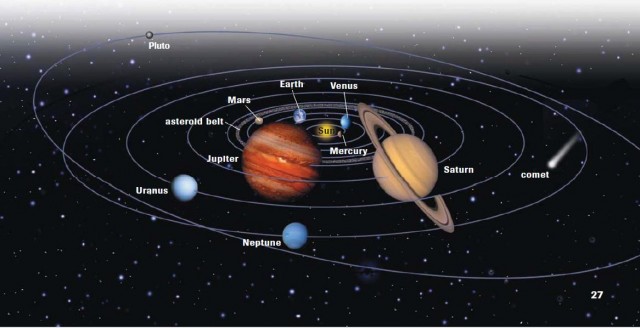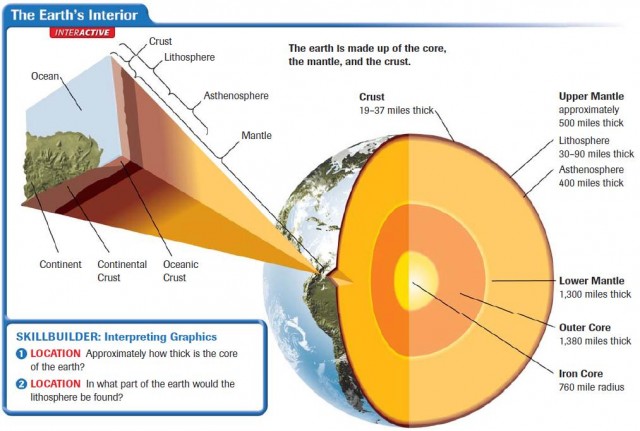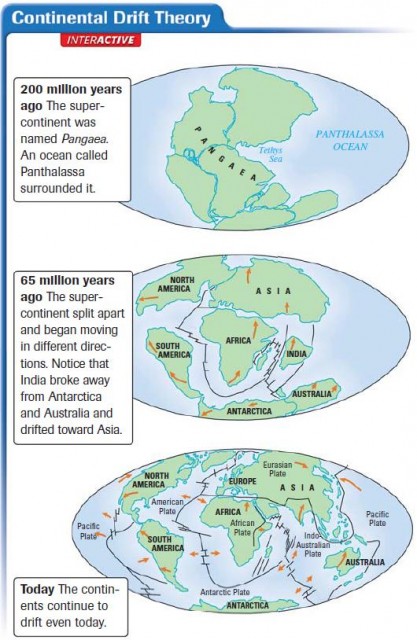The Earth Inside and Out
A HUMAN PERSPECTIVE A quick look at a world map will convince you that the continents, landmasses above water on earth, fit together like a huge jigsaw puzzle. South America and Africa are good examples. With imagination, you can see how other continents might fit together as well. The first person to suggest that the seven continents were once all one supercontinent was Englishman Francis Bacon in 1620. Bacon's idea received support in the early 1900s, when scientists found rocks in Africa that matched rocks in South America. Other evidence also supported the idea of a supercontinent millions of years ago.
The Solar System
The “home address” of the earth is the third planet in the solar system of the sun, which is a medium-sized star on the edge of the Milky Way galaxy. Its distance from the sun is 93 million miles. The solar system consists of the sun and nine known planets, as well as other celestial bodies that orbit the sun. The solar system also contains comets, spheres covered with ice and dust that leave trails of vapor as they race through space. Asteroids—large chunks of rocky material—are found in space as well. As you can see in the diagram, our solar system has an asteroid belt between the orbits of Jupiter and Mars.

The Structure of the Earth
The earth is about 24,900 miles in circumference and about 7,900 miles in diameter. Although the earth seems like a solid ball, it is really more like a series of shells that surround one another.
INSIDE THE EARTH
The core is the center of the earth and is made up of iron and nickel. The outer core is liquid, but the inner core is solid. Surrounding the core is the mantle, which has several layers. The mantle contains most of the earth's mass. Magma, which is molten rock, can form in the mantle and rise through the crust, the thin layer of rock at the earth's surface. Study the diagram below to learn more about the earth's interior.
ON AND ABOVE THE EARTH
Surrounding the earth is a layer of gases called the atmosphere. It contains the oxygen we breathe, protects the earth from radiation and space debris, and provides the medium for weather and climate. The solid rock portion of the earth's surface is the lithosphere, which includes the crust and uppermost mantle. Under the ocean, the lithosphere forms the seafloor. The huge landmasses above water are called continents. There are seven continents: North America, South America, Europe, Asia, Africa, Australia, and Antarctica. The hydrosphere is made up of the water elements on the earth, which include oceans, seas, rivers, lakes, and water in the atmosphere. Together, the atmosphere, the lithosphere, and the hydrosphere form the biosphere, the part of the earth where plants and animals live.

CONTINENTAL DRIFT
In 1912, Alfred Wegener of Germany presented a new idea about continents—the continental drift hypothesis. It maintained that the earth was once a supercontinent that divided and slowly drifted apart over millions of years.
Wegener called the supercontinent Pangaea (from a Greek word meaning “all earth”). An ocean called Panthalassa surrounded it. The supercontinent split into many plates that drifted, crashed into each other, and split apart several times before they came to their current positions. This process occurred over millions of years.
In the 1960s, scientists studying the sea floor discovered that the youngest rocks were in the middle of the ocean, at long cracks in the crust. This suggested that the new sea floor was being added, pushing the continents apart.
